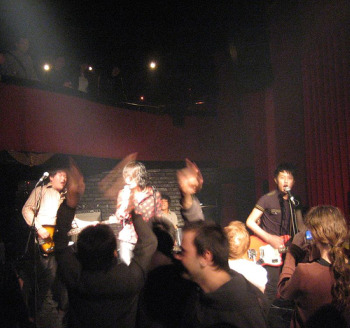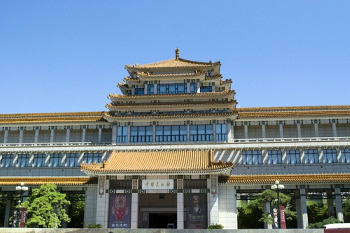Beijing is a city with more than 3,000 years of recorded history and a glorious cultural heritage; yet it is also a bustling metropolis that has given birth to an artistic youth movement in recent years.
Today’s Beijing is a place where ancient historical sights stand side-by-side with a thriving avant-garde culture. Modern China is a place with an identity collision and messy schizophrenia between old and new.
Let’s explore the dichotomy of the exciting new Beijing juxtaposed against the older elements of the city.
Beijing could be a great addition to your round the world trip itinerary.
The Sights of Beijing
Old Beijing: Forbidden City
The Forbidden City and Imperial Palace remain must-see sights in Beijing, and are amazing places of grandeur and history.
Built from 1406 to 1420, the immense complex includes 980 surviving buildings (covering nearly eight million square feet) that served as the imperial residence and court for 24 emperors from the Ming Dynasty through the Qing Dynasty.
The intricate design of mostly wooden buildings showcases ancient Chinese palatial architecture, surrounded by a moat and many beautiful gardens.
This UNESCO World Heritage site is the world’s largest surviving palace complex, providing a glimpse into a bygone world of royal splendor.
>> Insider Tip: Check out Yin, the rooftop bar at the Emperor Hotel, overlooking the Forbidden City for the best views in Beijing.
New Beijing: Houhai Lake

The bohemian Houhai Lake is one of the hippest spots in Beijing. One of several lake areas near Tiananmen Square, Houhai is also known as the “back lake” and is home to scores of restaurants, bars, coffee houses and boutiques set along cobblestone lanes.
Stroll along the water and over charming arched bridges as you hop from hotspot to hotspot – or hire one of the numerous rickshaws that ply the area.
Even more fun, rent a two- or three-person bicycle to ride down Lotus Lane, the most happening street in Houhai.
>> Insider Tip: The be-seen place in Houhai is Bar No Name, owned by cellist Bai Feng and known as the Cathedral of Cool. It has no address, either, but look for a vine-covered wooden structure by the Yinding Bridge.
The Music of Beijing
Old Beijing: Peking Opera
Traditional Peking Opera is alive and well, with its colorful costumes and elaborate makeup.
Accompanied by a crescendo of instruments, the unique sound of Chinese opera is different from any other in the world. The singing is usually accompanied by dancing, acrobatic stunts and even fight scenes, and the opera is played out much the same as it has been done since its origin in the late 18th century.
Most operas are either comedies or tragedies, and many historical events in Chinese history have been adapted into operatic plays.
>> Insider Tip: See a performance at the 340-year-old Zhengyici Theatre, the oldest wooden theater in Beijing and most authentic Peking Opera venue.
New Beijing: Experimental Music

Beijing’s experimental music scene defines the entire contemporary musical sound of the country.
The city has a thriving punk-rock counterculture that has been likened to that of New York City in the 1970s.
Young artists are creating their own innovative sounds in different styles including post-punk, noise rock and alternative folk.
In the world of music where everyone is continually waiting for the next big thing, it seems Beijing may have created it.
>> Insider Tip: Two of the hottest punk bands are P.K. 14 and Carsick Cars, often playing at Beijing’s premier club, D-22 – often called the Chinese CBGB.
The Arts in Beijing
Old Beijing: Beijing Art Museum

The Beijing Art Museum of the Imperial City (BAMOIC) houses an extensive collection of priceless historic treasures – including bronze and jade pieces from the 3rd century B.C. to the 17th century, as well as paintings, calligraphy, ivory and wood carvings, porcelains, ancient pottery and Buddhist scriptures.
The building itself is located in the Wanshou Temple, the temple of longevity, built in 1577 and serving as the place for birthday celebrations during the Ming and Qing Dynasties.
>> Insider Tip: The BAMOIC recently unveiled a new contemporary art collection that features emerging talent from around the world, offering you the chance to see the old and new juxtaposed in one place.
New Beijing: 798 Arts District
The 798 Arts District is an important haven for the creative class, housed in once-decaying state-owned factories and warehouses from the 1950s.
This industrial wasteland has been reborn into what just might be the most eclectic and vibrant artistic venue anywhere in the world.
Expanding outward from Originality Square, 798 is home to hundreds of art galleries, studios, boutiques (selling everything from high fashion to Mao kitsch), bookstores, restaurants and bars – all housed in the Bauhaus-style buildings.
Simply walking around can lead to fascinating discoveries.
>> Insider Tip: The Dashanzi International Art Festival is held every year from late April through May, showcasing cutting edge art forms in a lively atmosphere with music and film as well.
The Foods of Beijing
Old Beijing: Peking Duck
Peking Duck is the ubiquitous dish from this city, and its preservation as both a delicacy to eat and art form in its preparation is alive and well. This famous dish has been made since the Imperial era and is a national food of China.
Roasted in an open-flame wood oven for hours to achieve the crispy skin and flavor, the duck is then traditionally sliced in front of diners and eaten with a rich hoisin sauce and spring onions on thin crepes.
>> Insider Tip: While the centuries-old restaurants Quanjude and Bianyifang are famous spots to partake of this delicacy, try 1949 The Hidden City. This chic enclave of restaurants, coffee/sweet shop and a contemporary art gallery is located in the restored China Machinery factory, and the Duck de Chine serves one of the best Peking ducks in town.
New Beijing: Fusion Cooking
Modern China is a melting pot of exciting fusion cuisines, where Chinese chefs and celebrated foreigners alike are creating innovative new worlds for the palate.
Indulge in the epicurean discovery that is today’s Beijing dining scene at top restaurants such as Daniel Boulud’s Maison Boulud, serving French cuisine prepared with Pacific Rim ingredients in the walled compound of the former US Embassy.
Or, try Ristorante Sadler, the newest offering from Italian chef Claudio Sadler in the Legation Quarter, just steps from Tiananmen Square. Jing is the city’s leading modern Chinese restaurant, located in the swanky Peninsula Hotel.
>> Insider Tip: You don’t have to go upscale to taste the wonders of Beijing food. Check out the crazy fun of the Donghuamen Night Market, a collection of street food stalls featuring such exotic offerings as seahorse, scorpions and starfish on a stick.
photo credits: Beijing post-punk show by Prince Roy, Beijing art museum by buyalex, all other photos by Shelley Seale and may not be used without permission